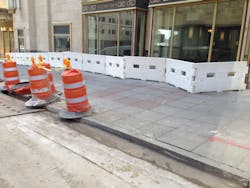Columbus, Ohio, builds accessible work zones
When a city or county calls about sidewalk closures or pedestrian work zones, Gary Boylan is quick to respond.
Boylan, vice president of Paul Peterson Co., a Columbus, Ohio, traffic-control company, is well-versed in pedestrian pathways, and ready with answers.
“Cities want to upgrade their pedestrian work zones for their streets,” Boylan said. “They want them safer, and less confusing to pedestrians. They want people to get through easily and quickly, and they don’t want anybody to get hurt.”
That means, Boylan continued, “No more tape and drum set-ups to guide pedestrians. They want ADA-compliant devices in their work zones to do the guiding.”
Boylan knew it was only a matter of time. The tape and drum set-up has flaws. A drum does not interlock, it is not a continuous device, and the tape doesn’t make it so. As such, there are usually gaps that pedestrians can walk through.
Lifting the tape up to cut across the street is a relatively easy task for most pedestrians. Pedestrians with limited vision who rely on hand guidance can miss the tape entirely. Pedestrians with limited vision who rely on walking devices might not detect any guidance at all, because of the gap between drums.
“It’s just not very safe. But, don’t take my word for it,” Boylan said. “Check the MUTCD Section 6F.74.
“Sometimes I read it right out of the manual,” he added. “I almost know it by heart now.”
In place of tape and drum, Paul Peterson uses SafetyWall ADA-Compliant Pedestrian Longitudinal Channelizer, manufactured by Plastic Safety Systems.
Boylan discovered the ADA-Compliant device while at an ATSSA Ohio Chapter “how-to” conference.
“This new device really appealed to me,” Boylan said. “First, it gives all pedestrians so much guidance . . . pedestrians who can see, and those who can’t.”
A pedestrian longitudinal channelizer provides three types of guidance through the work zone:
- Visible guidance;
- Trailing a hand along the smooth, continuous upper surface; and
- Tapping a walking device against the lower surface.
The conversion to ADA-compliant work zones is well on its way, Boylan said. The use of tape and drum will eventually disappear.
